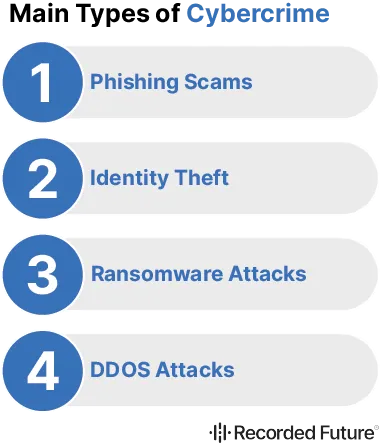Types of Cyber Crime: A Guide to Prevention & Impact
Phishing, identity theft and ransomware are all around us. Ever seen an email that screamed “phishy”? Or heard of identities hijacked online? Welcome to the frontlines of cybercrime. This guide covers the types of cybercrime, their impact and how to prevent them so you can stay ahead of online threats.
Cybercrime is a broad term that encompasses many malicious activities exploiting digital technologies, affecting individuals, businesses and governments worldwide. Cyber crime continues to escalate, causing significant financial and psychological impacts.
Phishing, identity theft and ransomware are some of the most common cyber crimes with severe financial and psychological impact on victims.
To combat cybercrime you need a multi-layered approach that includes threat intelligence solutions, antivirus software, VPNs and security awareness training backed by a solid legal framework and professional cybersecurity expertise.
What is Cybercrime?
Cybercrime involves unlawful actions executed using computers or the internet, focusing on attacking networks, stealing data, or committing fraud. This encompasses activities like unauthorized system access, identity theft, and online scams.

Cyber crime was first recognized in the 1970s as illicit activities exploiting digital technologies. It has grown up and is now a global problem, encompassing many malicious activities. From individual cybercriminals to organized groups, cyber crime has become a social epidemic that knows no borders. Cyber criminals use psychological manipulation, phishing, and malware to exploit individuals and organizations, causing financial losses and disrupting business operations. The rise of cryptocurrencies, the dark web and sophisticated scams and the shortage of cybersecurity professionals has added fuel to the fire.
These threats are not limited to any one demographic or industry. From unsuspecting individuals to multinationals and even governments, no one is safe. The cybercrime monster is growing and poses a threat to our security, privacy and way of life. In fact Statista predicts the ‘Estimated Cost of Cybercrime’ will rise by 5.7 trillion USD (a 69.94% increase) from 2023 to 2028 to 13.82 trillion USD by 2028 after 11 years of growth. Cyber crime is getting more frequent and complex with new tactics and huge costs impacting public and private sectors worldwide. This is why cyber crime investigation is more important than ever to mitigate these financial losses.
For more on how cybercriminals think read Andrei Barysevich’s blog post ‘Inside the Mind of Cybercriminals’. His research on the dark web reveals their tactics and strategies.
Types of Cybercrime
Understanding the most common types of cybercrime is key to fighting it. Let’s take a look at some of the most prevalent ones: phishing scams, identity theft, ransomware attacks, and DDOS. Note that this list is not exhaustive, but it covers the main types of cybercrime.

Phishing Scams
Phishing scams are one of the most common types of cybercrime. These scams involve fake emails or messages designed to trick victims into giving up personal or corporate information. Cybercriminals use social engineering to trick users into revealing confidential information such as login credentials and credit card numbers.
Phishing scams often involve malicious software like viruses, worms, and trojans.
Phishing scams come in many forms. From emails that look like legitimate companies to messages saying you’ve won a prize, cybercriminals are getting more sophisticated. The information targeted in phishing attacks is broad – personal, financial and even sensitive business data. Recognizing the signs of a phishing email can stop cybercrime.
In addition to personal and financial data risks, phishing attacks pose a big threat to brand reputation. Cybercriminals often use a company’s identity to execute these scams and damage the trust and confidence customers have in the brand. Having robust brand monitoring and protection solutions in place is key in this landscape not only to protect sensitive information but also to maintain the integrity and reputation of the business to its stakeholders.
Identity Theft
Identity theft is a serious form of cybercrime. It’s when cybercriminals get your personal information such as transactional data to make unauthorized transactions or enable other fraudulent activities. Cyber criminals use stolen personal information for unauthorized transactions and other fraudulent activities. The effects of identity theft can be huge. Some of the consequences are:
- Unexplained withdrawals from bank accounts
- Mysterious credit card charges
- Psychological distress
- Financial losses
- Legal problems
These signs are hard to detect until it’s too late so be sure to protect yourself from identity theft
Ransomware Attacks
Ransomware attacks are a type of malicious software that exploit computer networks to encrypt victims’ files and block access until a ransom is paid. This type of cybercrime can lead to data breaches where victims pay the ransom to get access back to their files or systems. A recent Splunk report showed that 43% of organizations hit by ransomware have had their data or systems held for ransom.
Ransomware is usually distributed through phishing emails or drive-by downloading. Once inside a computer system, the malicious software spreads its arms, encrypts files, and demands a ransom, often in the form of cryptocurrency, in exchange for the decryption key. Today understanding and implementing proactive ransomware protection is more important than ever.
DDOS Attacks
DDOS, short for Distributed Denial of Service, are severe cyberattacks where a multitude of compromised systems flood a single target with excessive traffic, effectively causing a service outage for regular users. These incidents utilize vast networks of hijacked computers, known as botnets, to launch overwhelming traffic assaults that incapacitate websites and online services.
The reasons behind these attacks are varied, encompassing motives such as financial gain, political statements, or personal disputes. With the continuous growth of the internet, both the frequency and magnitude of DDOS attacks have escalated, posing a persistent threat to organizations and businesses globally.
Emerging Cybercrime Trends
Cybercriminals adapt to technology. They are using emerging technologies like cryptocurrency and blockchain to steal funds from exchanges, wallets and smart contracts and even using blockchain for money laundering. Phishing attacks have also gotten more sophisticated with cybercriminals using real-world events like tax season and shopping promotions to lure victims.
Other emerging trends are cyberactivism, automotive hacking and the impact of artificial intelligence (AI) on cybercrime. In fact, recent studies showed that 85% of the increase in cyber threats is attributed to bad actors using generative AI, so the challenges in digital security are evolving. As cyber crime continues to evolve with new technologies and tactics, the financial impact on the economy and global GDP is enormous.
Impact to Individuals and Businesses
Cybercrime can affect many. Individuals and businesses can lose a huge amount of money due to fund theft, unauthorized transactions or expenses for recovery and strengthening of the system after an attack or data breach. Cyber crime continues to cause financial losses and disrupt business operations.
Beyond financial losses, cybercrime can also cause reputational damage, resulting in job loss, difficulty in finding new jobs, loss of customers and decreased revenue. In some cases victims may also face legal consequences including huge fines or lawsuits and even imprisonment.
Also, the psychological impact to victims of cybercrime can be huge, often resulting in fear, anxiety, betrayal and emotional distress.
Preventing cybercrime is multi-faceted. It requires best practices and use of various tools such as threat intelligence software, antivirus solutions, Virtual Private Networks (VPNs) and security awareness training. This is not an exhaustive list but the minimum individuals and organizations should do when fighting cybercrime.
Strong foundation in cybersecurity concepts and leadership skills is key to preventing cyber crime.
Threat Intelligence
Threat Intelligence helps you to identify, investigate and prioritize cyber threats. It’s like having a cyber detective on your side to help you understand your unique threat landscape and take proactive actions to prevent and mitigate potential attacks. This intelligence provides real-time, actionable insights to your security team to search, identify, alert and prioritize threats, reducing risk to your business. Threat intelligence also helps identify and mitigate the tactics used by cyber criminals, such as phishing, malware, and ransomware attacks.
In short, Threat Intelligence gives you actionable intelligence on your threats. It enables your security team to proactively identify and investigate cyber threats so they stay one step ahead. By keeping an eye on emerging threats and trends you can outsmart cybercriminals and strengthen your cybercrime prevention.
Antivirus Software and Malicious Software
Antivirus software is a first line of defense against cybercrime, scanning for and neutralizing malicious software. It scans programs and files for threats, compares it to a database of known malware, including viruses, worms, trojans, adware, spyware, and ransomware, and neutralizes potential threats. No antivirus solution is 100% effective against all threats but regularly updated antivirus software is essential. But users should also be aware of the downsides such as system slowdown, false positives and frequent ads or upselling.
Virtual Private Networks (VPNs)
VPNs add an extra layer of security to your internet connection. By creating a secure and encrypted connection between your device and the internet, VPNs protect your data from being intercepted or traced by cybercriminals. VPNs can protect against:
- Viruses
- Malware
- DDoS attacks
- Spoofing attacks
- Hackers
By encrypting your traffic and hiding your IP address, VPNs can minimize cybercrime.
Security Awareness Training
Fighting cybercrime requires training, in this case, security awareness is key. By educating employees about the dangers and teaching them how to identify and avoid such risks, companies can reduce their chances of being hit by cybercrime.
A good security awareness program should cover:
- Password management
- Safe internet use
- Incident reporting
Regular training can give employees the tools to protect themselves and the organization from cyber threats.
After that, Recorded Future University’s threat intelligence training can take your team to the next level, with specialized insights into the latest cyber threat landscape.
Legal Framework and Reporting Cybercrime
The legal framework for cybercrime is complex, each country has its own definition and penalties. 156 countries have cybercrime laws, Europe has the highest adoption rate at 91%. Cybercrime victims should report incidents to the relevant authorities. In the US, victims can report to the Internet Crime Complaint Center or local offices of federal law enforcement.
Fighting Cybercrime: Cybersecurity Professionals
Cybersecurity professionals are on the front line of fighting cybercrime. They:
- Develop and implement security controls
- Investigate cyber crime incidents
- Keep up-to-date with the latest threats and trends
- Prevent cyber attacks
- Secure IT infrastructure, networks and data.
Cybersecurity professionals also help develop security policies and procedures, to help organizations manage risk and comply with laws and ethical standards. They use:
- Wireshark
- Nagios
- Nessus Professional
- Acunetix
- Snort
To detect and mitigate cyber threats, including cyber terrorism, you need to have effective cyber security in place to prevent cyber crime.
FAQs
What are the 4 main types of cybercrime?
The 4 main types of cybercrime are hacking, fraud, harassment and identity theft. You should protect yourself and your data in this digital age.
How many types of cybercrime are there?
There are many types of cybercrime, hacking, phishing, identity theft, ransomware and malware attacks. Cybercrime is global and crosses borders.
What are 3 examples of cybercrime?
Three examples of cybercrime are phishing and scam, identity theft and ransomware attacks. Be aware of these when using the internet.
What is phishing and how do I spot it?
Phishing is a scam where cybercriminals use fake emails or messages to trick people into sharing personal data. Look for suspicious requests, urgent language and unusual formatting in the message.
How do I prevent identity theft?
To prevent identity theft, protect your personal data, be careful with online sharing and monitor your accounts regularly. Be proactive in detecting any unusual activity.
Summary
In summary, fighting cybercrime is a team effort. Whether we’re individuals browsing the web, organizations protecting sensitive data or cybersecurity professionals on the front line, we all have a role to play. By learning, implementing and staying up-to-date with the latest threats and trends we can make the digital world a safer place for everyone.
Browse the digital world safely with Recorded Future. Our solutions combat cybercrime from phishing to ransomware and more. Protect your data now. Contact us and book your demo with Recorded Future today.

Esteban is a seasoned security researcher and IT professional with over 20 years of experience, specializing in hardening systems and networks, leading blue team operations, and conducting thorough attack surface analysis to bolster cybersecurity defenses. He's also a skilled marketing expert, specializing in content strategy, technical SEO, and conversion rate optimization. His career includes roles as Security Researcher and Head of Marketing at SecurityTrails, before joining the team at Recorded Future.
Related
